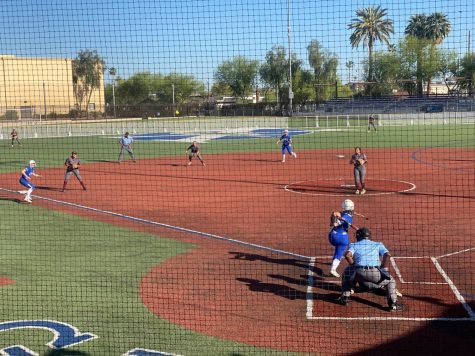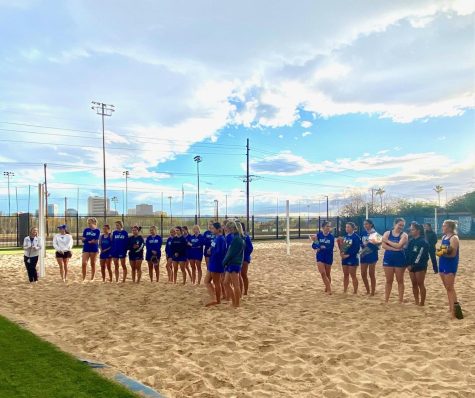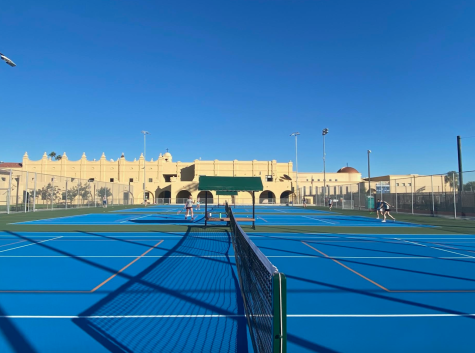Dolphinaris: how one company’s success killed four dolphins

Caroline Liddy, class of 2018, and senior Helen Innes pose at a protest against Dolphinaris in the fall of 2016. Photo courtesy of Helen Innes ’19
Four dolphins, half of the original eight, have died since 2016 at Dolphinaris Arizona. Now, the company has announced that it will temporarily be closing because of it. Since the first dolphin death, and even before then, an organization called Dolphin Free AZ has protested the opening of the company and now are gaining more momentum than ever.
I protested against the opening of Dolphinaris before in the fall of 2016, and that article can be found here. For personal reasons, I have found that captivity is not the answer to learning more about our natural environment, especially after watching movies like Blackfish, a documentary about Seaworld’s whale captivity program. And now, with a similar company opening just in my backyard, I knew that it was time to act, so I did. But with the death of Dolphinaris’ fourth dolphin, it is time for the public to wake up.
Senior Jillian Peterson added that, “Dolphinaris is an inhumane organization for keeping these dolphins captive when they are meant to be free in the ocean as human contact with dolphins is deadly.”
Dolphinaris announced that it would be opening on Oct. 15, 2016 in Scottsdale on the Salt River Reservation. This location is the first of the company’s locations outside of Mexico. There are five other locations in Mexico along the Yucatan Peninsula near Cancun. The Scottsdale aquatic attraction offered close-up viewing of dolphins and a “Beach Club”, fitted with a swimming pool and other ways to interact with the dolphins. The company also has an aquarium and a butterfly exhibit, called Butterfly Wonderland, which is next to OdySea in the desert. However, the two companies have different owners. Dolphinaris is currently “owned by Ventura Entertainment, and the company’s Arizona branch lists CEO Mauricio Martinez del Alva and two other Mexico residents as its owners, according to the Arizona Corporation Commission,” AZ Central reported.
Visitors are allowed, and encouraged to get in the water with the dolphins as the company boasts itself as, “one of the world’s leading provider of dolphin experiences,” according to the company’s website.
The latest dolphin to die was Kai, an 22-year-old dolphin on Jan. 31. Just one month before, Khloe, an 11-year-old Atlantic bottlenose dolphin died on Dec. 30, according to AZ Central. Now, with only four dolphins remaining, the company has decided to transport the dolphins to other facilities while experts examine Dolphinaris’ environment and welfare.
After the last death, the Animal and Plant Health Inspection Service, which monitors animal care under the U.S. Department of Agriculture, has said that it is “working on the next course of action” when looking at the prospects of the investigations taking place at Dolphinaris, AZ Central reported.
The company has since encouraged veterinarians and animal welfare officials to visit the facilities. Employees have told the media that they are just as distraught with the death of the dolphins as the media.
The constant death of dolphins at Dolphinaris has certainly swayed opinions when it comes to the dolphin attraction. Perhaps this is helping the work of Dolphin Free AZ. While the group feels process with the temporary closing of Dolphinaris, it is only temporary. The group is currently working with the Animal Defense League of AZ, the Animal Welfare Institute, the Ric O’Barry’s Dolphin Project, the Lightkeepers Foundation and Plea for the Sea to keep “putting pressure on Dolphinaris to keep their doors closed forever,” according to Dolphin Free AZ’s Facebook page.
Dolphin Free AZ is still conducting protests outside of the reservation, saying on their Facebook page that, “Dolphinaris Arizona has *not* indicated “permanent closure”, despite some news that has been reported today [the death of its fourth dolphin]. Until we hear it from Dolphinaris Arizona, we move forward. … We cannot become complacent. … SHUT IT DOWN!”
Lastly, senior Miranda Chavira put it simply, “We are in a desert and they [dolphins] should be free and in the ocean.”







